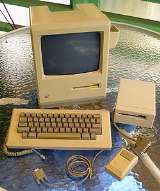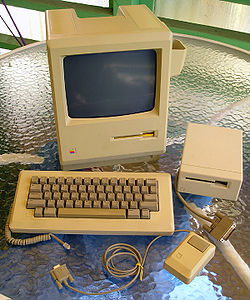
Macintosh 512K
Encyclopedia

Macintosh 128K
The Macintosh 128K machine, released as the "Apple Macintosh", was the original Apple Macintosh personal computer. Its beige case contained a monitor and came with a keyboard and mouse. An indentation in the top of the case made it easier for the computer to be lifted and carried. It had a selling...
. It was virtually identical to the previous Mac, differing primarily in the amount of built-in memory (RAM
Ram
-Animals:*Ram, an uncastrated male sheep*Ram cichlid, a species of freshwater fish endemic to Colombia and Venezuela-Military:*Battering ram*Ramming, a military tactic in which one vehicle runs into another...
), which quadrupled the original's. This large increase earned it the nickname Fat Mac. The additional memory was significant because more ambitious users with computer experience stretched the capacity of the original Mac almost immediately, despite the limited number of applications.
Processor and memory
Like the 128K Macintosh before it, the 512K contained an 8 MHz Motorola 68000 connected to a 512 KBKilobyte
The kilobyte is a multiple of the unit byte for digital information. Although the prefix kilo- means 1000, the term kilobyte and symbol KB have historically been used to refer to either 1024 bytes or 1000 bytes, dependent upon context, in the fields of computer science and information...
DRAM
Dram
Dram or DRAM may refer to:As a unit of measure:* Dram , an imperial unit of mass and volume* Armenian dram, a monetary unit* Dirham, a unit of currency in several Arab nationsOther uses:...
by a 16-bit
16-bit
-16-bit architecture:The HP BPC, introduced in 1975, was the world's first 16-bit microprocessor. Prominent 16-bit processors include the PDP-11, Intel 8086, Intel 80286 and the WDC 65C816. The Intel 8088 was program-compatible with the Intel 8086, and was 16-bit in that its registers were 16...
data bus. Though the memory had been quadrupled, it could not be upgraded. A 64 KB ROM chip boosts the effective memory to 576 KB, but this is offset by the display's 22 KB framebuffer
Framebuffer
A framebuffer is a video output device that drives a video display from a memory buffer containing a complete frame of data.The information in the memory buffer typically consists of color values for every pixel on the screen...
, which is shared with the DMA
Direct memory access
Direct memory access is a feature of modern computers that allows certain hardware subsystems within the computer to access system memory independently of the central processing unit ....
video controller. It shared a revised logicboard with the re-badged Macintosh 128K (previously just called the Macintosh), which streamlined manufacturing.
Software
The applications MacPaintMacPaint
MacPaint was a bitmap-based graphics painting software program developed by Apple Computer and released with the original Macintosh personal computer on January 22, 1984. It was sold separately for US$195 with its word processor counterpart, MacWrite. MacPaint was notable because it could generate...
and MacWrite
MacWrite
MacWrite was a word processor application released along with the first Apple Macintosh systems in 1984. It was the first such program that was widely available to the public to offer WYSIWYG operation, with multiple fonts and styles...
were still bundled with the Mac. Soon after this model was released, several other applications became available, including MacDraw
MacDraw
MacDraw was a vector based drawing application released along with the first Apple Macintosh systems in 1984. MacDraw was one of the first WYSIWYG drawing programs that could be used in collaboration with MacWrite. MacDraw was useful for drawing technical diagrams and floorplans...
, MacProject
MacProject
MacProject was a project management and scheduling business application released along with the first Apple Macintosh systems in 1984. MacProject was one of the first major business tools for the Macintosh which enabled users to calculate the "critical path" to completion and estimate costs in...
, Macintosh Pascal and others. In particular, Microsoft Excel
Microsoft Excel
Microsoft Excel is a proprietary commercial spreadsheet application written and distributed by Microsoft for Microsoft Windows and Mac OS X. It features calculation, graphing tools, pivot tables, and a macro programming language called Visual Basic for Applications...
, which was written specifically for the Macintosh, required a minimum of 512 KB
Kilobyte
The kilobyte is a multiple of the unit byte for digital information. Although the prefix kilo- means 1000, the term kilobyte and symbol KB have historically been used to refer to either 1024 bytes or 1000 bytes, dependent upon context, in the fields of computer science and information...
of RAM, but definitively solidified the Macintosh as a serious business computer. Models with the enhanced ROM also supported Apple's Switcher, allowing cooperative multitasking among (necessarily few) applications.
New Uses
The LaserWriterLaserWriter
The LaserWriter was a laser printer with built-in PostScript interpreter introduced by Apple in 1985. It was one of the first laser printers available to the mass market...
became available for the first time shortly after the 512K's introduction, making home desktop publishing a possibility for the first time, although the LaserWriter's initial US$6,995 price put it far out of the reach of most individuals. It utilized Apple's built-in networking scheme LocalTalk
LocalTalk
LocalTalk is a particular implementation of the physical layer of the AppleTalk networking system from Apple Computer. LocalTalk specifies a system of shielded twisted pair cabling, plugged into self-terminating transceivers, running at a rate of 230.4 kbit/s...
which made it more affordable shared among several users. In addition, the 512K became the earliest Mac capable of supporting Apple's AppleShare
AppleShare
AppleShare was a product from Apple Computer which implemented various network services. Its main purpose was acting as a file server, using the AFP protocol...
built-in file sharing network, when introduced in 1987. More importantly the expanded memory in the 512K allowed it to better handle large word-processing documents and take better use of the graphical user interface and generally increased speed. In particular, combined with the LaserWriter, the introduction of Aldus PageMaker
Adobe PageMaker
PageMaker was one of the first desktop publishing programs, introduced in 1985 by Aldus Corporation, initially for the then-new Apple Macintosh and in 1987 for PCs running Windows 1.0....
software, which took full advantage of the extra RAM, revolutionized the publishing industry and solidified the Macintosh as the de-facto desktop publishing computer.
System software
The original 512K could accept Macintosh system software up to version 4.1; System Software 5 was possible if used with the Hard Disk 20; With the OEM 800 KB Drive and ROM upgrade kit a 512Ke could accept up to System 6.0.8.Upgrades

Macintosh 512Ke
The Macintosh 512K enhanced was introduced in April 1986 as a cheaper alternative to the top-of-the-line Macintosh Plus, which had debuted three months previously. It was the same as the Macintosh 512K but with the 800K disk drive and 128K of ROM used in the Macintosh Plus. Like its predecessors,...
in April 1986. It differed from the original 512K in that it had an 800 KB floppy disk drive
Macintosh External Disk Drive
The Macintosh External Disk Drive was the original of a series of external 3.5" floppy disk drives manufactured and sold by Apple Computer exclusively for the Macintosh series of computers introduced in January, 1984. Later, Apple would unify their external drives to work cross-platform between the...
and the same improved ROM
Old World ROM
Old World ROM Macintosh computers are the Macintosh models that use a Macintosh Toolbox ROM chip, usually in a socket . All Macs prior to the iMac use Old World ROM, while the iMac and all subsequent models until the introduction of the Intel-based EFI Models are New World ROM machines...
as the Macintosh Plus
Macintosh Plus
The Macintosh Plus computer was the third model in the Macintosh line, introduced on January 16, 1986, two years after the original Macintosh and a little more than a year after the Macintosh 512K, with a price tag of US$2599...
. With the exception of the new model number (M0001E), they were otherwise cosmetically identical. The stock 512K could also use an 800 KB floppy disk drive as well as the Hard Disk 20
Hard Disk 20
The Macintosh Hard Disk 20 was the first hard drive developed by Apple Computer specifically for use with the Macintosh 512K. Introduced on September 17, 1985, it was part of Apple's long awaited solution toward completing the Macintosh Office announced in January 1985...
, the first hard disk manufactured by Apple exclusively for use with the 512K, but required a special system file (not required by the 512Ke) that loaded the improved ROM code into RAM, thus reducing the available RAM for other uses. Apple offered an upgrade kit which replaced the floppy disk drive and ROMs essentially turning it into a 512Ke. One further OEM upgrade replaced the logicboard and the rear case entirely with that of the Macintosh Plus
Macintosh Plus
The Macintosh Plus computer was the third model in the Macintosh line, introduced on January 16, 1986, two years after the original Macintosh and a little more than a year after the Macintosh 512K, with a price tag of US$2599...
.
As with the original Macintosh, the 512K was designed with no slots for upgrade boards, so the few internal upgrades that were available for the 512K had to plug directly into the 68000 processor socket. These included "snap-on" SCSI
SCSI
Small Computer System Interface is a set of standards for physically connecting and transferring data between computers and peripheral devices. The SCSI standards define commands, protocols, and electrical and optical interfaces. SCSI is most commonly used for hard disks and tape drives, but it...
cards, internal hard drives (such as the 10 MB General Computer
General Computer
General Computer was a computer peripheral company whose main product was the HyperDrive, the first internal hard disk for the original Apple Macintosh computer. The product was unusual because the Macintosh did not have any internal interface for hard disks...
hard disk, priced at US$2,195), and RAM upgrades of as much as 2 MB
Megabyte
The megabyte is a multiple of the unit byte for digital information storage or transmission with two different values depending on context: bytes generally for computer memory; and one million bytes generally for computer storage. The IEEE Standards Board has decided that "Mega will mean 1 000...
or more.
See also
- Macintosh 128KMacintosh 128KThe Macintosh 128K machine, released as the "Apple Macintosh", was the original Apple Macintosh personal computer. Its beige case contained a monitor and came with a keyboard and mouse. An indentation in the top of the case made it easier for the computer to be lifted and carried. It had a selling...
- Macintosh XLMacintosh XLMacintosh XL was a modified version of the Apple Lisa personal computer made by Apple Computer, Inc. In the Macintosh XL configuration, the computer shipped with MacWorks XL, a Lisa program that allowed 64 K Macintosh ROM emulation...
- Macintosh 512KeMacintosh 512KeThe Macintosh 512K enhanced was introduced in April 1986 as a cheaper alternative to the top-of-the-line Macintosh Plus, which had debuted three months previously. It was the same as the Macintosh 512K but with the 800K disk drive and 128K of ROM used in the Macintosh Plus. Like its predecessors,...
- Macintosh PlusMacintosh PlusThe Macintosh Plus computer was the third model in the Macintosh line, introduced on January 16, 1986, two years after the original Macintosh and a little more than a year after the Macintosh 512K, with a price tag of US$2599...
- Macintosh 128K/512K technical details
External links
- Macintosh 512K technical specifications at apple.com

